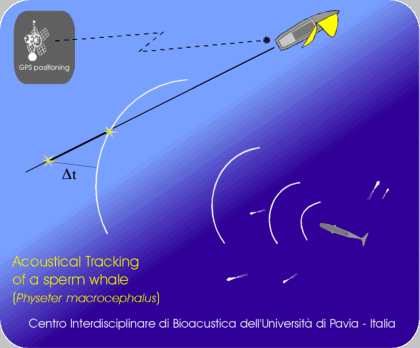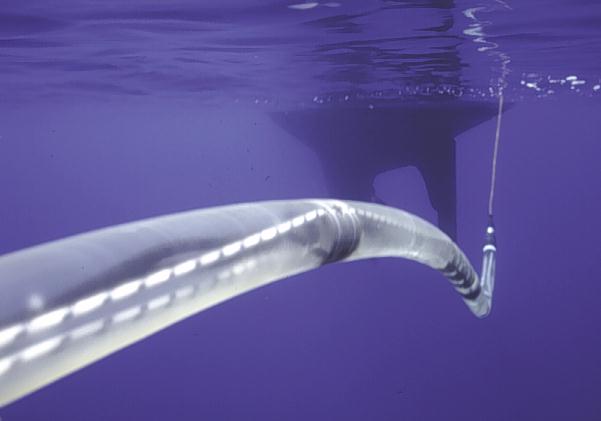
Università degli Studi di Pavia
Centro Interdisciplinare di Bioacustica e Ricerche Ambientali
Via Taramelli 24 - 27100 Pavia - Italy
e-mail : cibra@unipv.it
Underwater Bioacoustics
A short introductory chapter on
underwater bioacoustics, instrumentation and
methodologies.
Underwater acoustics
Underwater acoustics is a branch of acoustic science which
investigates the propagation of sound underwater.
Underwater acoustics is strictly related with the
development of the SONAR (Sound Orientation Navigation And
Ranging) which allows to detect underwater obstacles and
to measure the water depth to make navigation safer.
SONARs can be either active or passive. Active sonars emit
sounds and listen for the echoes reflected by underwater
objects. The most advanced ones allows to map the seabead
features and to discriminate among different objects, for
example to find mines.
Passive sonars simply listen for the sounds emitted
underwater by ships, submarines, ...and whales as well.
The major developments in passive sonars have been
initially accomplished for military purposes, i.e. to
detect submarines and ships by means of the noise emitted
by their engines and propellers.
Once-secret military hydrophones that were used to listen
for submarines are now providing acoustic data for more
peaceful purposes. Scientists are listening to whales,
tracking fish, and even measuring global temperature
changes using sound (ATOC - Acoustic Thermometry of Ocean
Climate). As sound waves move slightly faster in warm
water than in cold water, by measuring the time it
takes sound to travel underwater between two points,
scientists can figure out the average temperature along
that path.
Bioacoustics
Bioacoustics is a branch of zoology, strictly related to
ethology, that investigates sound production and reception
in animals, including ma, and how they communicate each
other by means of sound. Bioacoustics also concerns the
organs of hearing and the sound producing apparata as well
as the physiological processes by which sounds are
produced and received for communication as well as for
echolocation purposes. Finally, it attempts to understand
relationships between the features of the sounds an animal
produces and the nature of the environment in which they
are used and the functions they are designed to serve. Its
development dates effectively from about 1950, when
practical recording and analyzing methods became readily
available to the scientific community.
Underwater
Bioacoustics
Underwater bioacoustics studies the acoustic behaviour of
acquatic animals and the acoustic features of the
underwater environment in which they emit sounds. In the
underwater environment acoustic communication plays a
crucial role: the high propagation speed (about 1500
m/sec, five times than in air) and the low attenuation
with distance allow an effective acoustic transmission of
signals. Many texts of acoustics, electroacoustics and
bioacoustics may be consulted to get a better knowledge of
underwater acoustics; among them: Urick (1983), Au (1993),
Richardson et al. (1995).
Many of the organisms which live underwater, or near the
interface between air and water, produce sounds:
invertebrates, amphibians, reptiles, fishes, mammals. In
the marine environment, biological acoustic sources are
mainly represented by invertebrates ("snapping shrimps",
for example), fishes, and marine mammals (cetaceans and
pinnipeds).
The study of underwater acoustic communication is an
important branch of bioacoustics. It concerns not only the
characteristics of the acoustic signals by which organisms
communicate and echolocate but also the structure of the
organs for production and reception of signals, the
acoustic characteristics of the environment through
which signals propagate, as well as the development
of suitable instruments to detect and analyze sounds.
Many research projects focus on acoustics and underwater
bioacoustics in relation to the problem of conservation of
the fauna and to the environmental impact of human
activities. Scientific goals associated with monitoring
and management of the marine environment can benefit from
non intrusive study methods such as the detection of the
presence of certain species on the basis of their species
specific acoustic signals. The ability to detect and
recognize the acoustic signature of each species allows
the identification from a distance and, in certain cases,
the survey, tracking, and census of the animals, even
at a large distance or when lacking visual
observation.
Also, acoustics might be used to develop both active and
passive deterrent devices to warn echolocating cetaceans
on the presence of fishing nets and thus to prevent their
incidental take.
Since bioacoustic research involves the detection, the
systematic classification, and the analysis of animal
acoustic emissions, zoological sound libraries are of
primary importance. Sound libraries are national and
international institutions whose main task is to collect,
file, and preserve the recordings of animal voices and to
make them available to the scientific community as well as
to educational activities.
Hydrophones
Hydrophones are specially designed microphones that
transform sounds propagating underwater into electrical
signals. Regarded as single transducers, hydrophones are
usually omnidirectional and may cover a wide range of
frequencies, from a few Hz to more than 100 kHz. In the
marine environment, different and more complex hydrophonic
systems are used. They often consist of multiple
transducers (array of hydrophones) in order to be more
directional and sensitive.
By using a towed dipole array, made by just two
hydrophones spaced few meters, it is possible to assess
the direction of incoming sounds by measuring the time
delay of a same signal on the two transducers (TDA - Time
Difference of Arrival). The TDA is then used to determine
a conical surface on which the sound source is located; to
resolve the real bearing it is required to repeat the
measure after some change in the ship course. In this way
it is possible to locate the animal where conic surfaces
intersects.
To get a real source position to be plotted on a GIS the
position of the ship must continuously updated and
recorded with a GPS receiver.

Example of acoustic tracking of a sperm whale with a
dipole array
As far as the application in underwater
bioacoustics is concerned, there are two main kinds of
utilization of the transducers: stationary
mono/multi-hydrophonic configurations by which to control
selected areas, and towed hydrophonic arrays to
continuously detect sound during navigation.
Hydrophones may be connected to a receiving equipment for
recording and sound analysis by means of wires or a radio
transmitter. For some applications they may be packaged
with a recorder and batteries to operate autonomously for
periods of time extending from few hours to months. These
devices can be deployed on the sea bottom (or even
attached on an animal if they are compact enough) and then
retrieved for analysing the recordings.
Arrays used for military purposes, i.e. to detect submarines at great distances, may be very powerful and expensive. They are often made by hundreds of sensors and they are connected to very powerful processing systems able to perform beamforming in real-time. Beamforming is a technique based on the processing of signals detected by a series of sensors to produce a plot of received energy vs arrival direction; in other words, a beamformer allows to show the energy of received sound in a degree vs time plot. Thus it is possible to separate sources at different angles and to listen to a specific direction only. Arrays for studying marine mammals' sounds are often based on a small series of sensors to keep low the complexity, the weight and the cost of the array. A small array can be deployed and retrieved by hand from a small platform such as a motorsailing boat.

The dipole towed array of hydrophones developed by CIBRA and ALENIA
Sonobuoys
Sonobuoys are expendable devices developed and used to
detect submarines by either listening for the sounds
produced by propellers and machinery (passive detection)
or by emitting a sonar "ping" to be reflected by the
surface of a submarine (active detection). They are
basically consist in a hydrophone, an amplifier, a VHF
radio transmitter and a battery to provide energy for a
selected number of hours; all the electronics are located
in a cylindrical enclosure with a floater. They may be
dropped by aircrafts or deployed by ships and their radio
signals can be received within few miles.
Passive sonobuoys can be effectively used to detect and
record cetacean sounds too. There are several
sonobuoy types, among them, the Q57 type uses a calibrated
hydrophone for audio frequencies in the 10Hz to 20kHz
range.
Deployement of sonobuoys from the IT Navy RV Magnaghi (SOLMAR SIRENA 99)
Display of signals received from a sonobuoy (IT Navy RV Magnaghi, SOLMAR SIRENA 99)
Bottom deployed recorders
This type of recorder is a very special piece of
equipment that can be deployed on the sea bottom to record
sounds for a certain period, continuously or according to
a predefined scheduled, and then, at the end of the task,
it can be retrieved. The equipments needs to be waterproof
and pressure resistent; also, it needs long life batteries
to provide power to the recording electronics. At the end
of the task it can be retrieved in different ways; some
models have an acoustic release system to be activated by
a specific acoustic command sent from the surface. Once
released the equipment goes to the surface, pulled by
floaters, to be recovered.
Recording tags
This is another very special piece of recording equipment
to be attached on the back of an animal. The most
sophisticated one, named D-TAG, has been developed by the
WHOI team to record, other than sounds, the depth, the
orientation and the movements of the swimming animal to
reconstruct all its movements underwater along with the
sounds received and emitted by an animal. These features
are very important to document the behaviour of a diving
animal and in particular to record behavioural reactions
to the playback of sounds and noise in Controlled Exposure
Experiments (CEE).
The D-TAG is not invasive as it is attached with suction
caps; a timed release system detaches the tag after a
given number of hours and then the tag goes to the surface
and emits a radio-signal to drive the recovery operations.
Instruments developed by the Centro Interdisciplinare di Bioacustica:
Page written by G.Pavan, August 2005